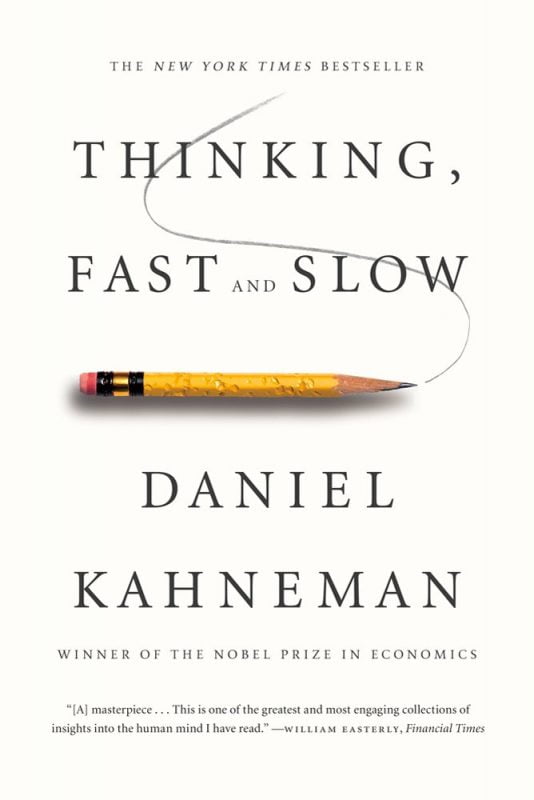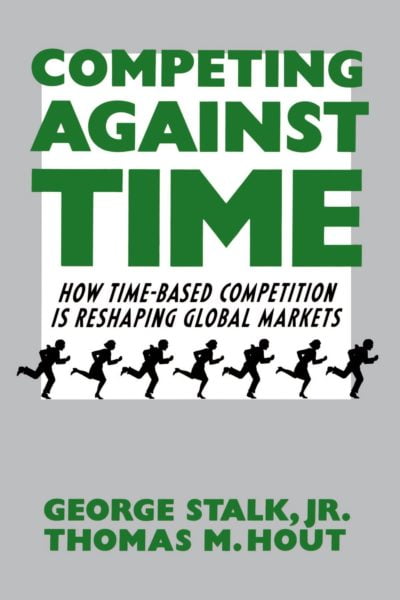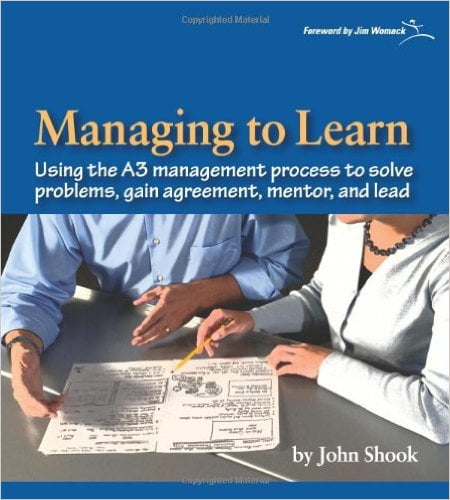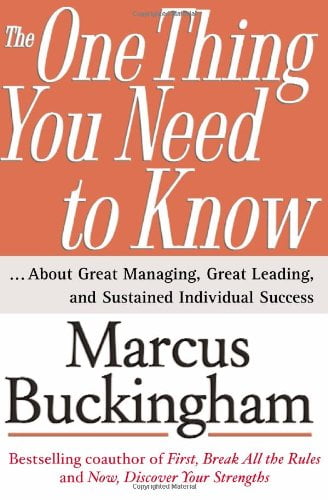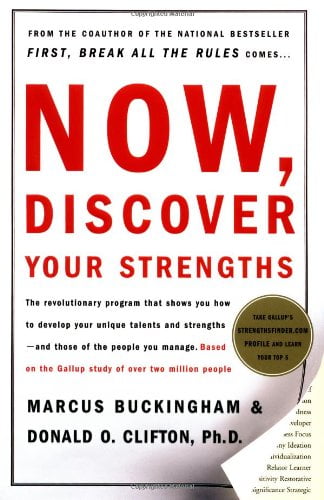Thinking, Fast and Slow
Major New York Times bestseller
Winner of the National Academy of Sciences Best Book Award in 2012
Selected by the New York Times Book Review as one of the ten best books of 2011
A Globe and Mail Best Books of the Year 2011 Title
One of The Economist's 2011 Books of the Year
One of The Wall Street Journal's Best Nonfiction Books of the Year 2011
2013 Presidential Medal of Freedom Recipient
Kahneman's work with Amos Tversky is the subject of Michael Lewis's The Undoing Project: A Friendship That Changed Our Minds
Competing Against Time: How Time-Based Competition is Reshaping Global Markets
Today, time is the cutting edge. In fact, as a strategic weapon, contend George Stalk, Jr., and Thomas M. Hout, time is the equivalent of money, productivity, quality, even innovation. In this path-breaking book based upon ten years of research, the authors argue that the ways leading companies manage time--in production, in new product development, and in sales and distribution--represent the most powerful new sources of competitive advantage.With many detailed examples from companies that have put time-based strategies in place, such as Federal Express, Ford, Milliken, Honda, Deere, Toyota, Sun Microsystems, Wal-Mart, Citicorp, Harley-Davidson, and Mitsubishi, the authors describe exactly how reducing elapsed time can make the critical difference between success and failure. Give customers what they want when they want it, or the competition will. Time-based companies are offering greater varieties of products and services, at lower costs, and with quicker delivery times than their more pedestrian competitors. Moreover, the authors show that by refocusing their organizations on responsiveness, companies are discovering that long-held assumptions about the behavior of costs and customers are not true: Costs do not increase when lead times are reduced; they decline. Costs do not increase with greater investment in quality; they decrease. Costs do not go up when product variety is increased and response time is decreased; they go down. And contrary to a commonly held belief that customer demand would be only marginally improved by expanded product choice and better responsiveness, the authors show that the actual results have been an explosion in the demand for the product or service of a time-sensitive competitor, in most cases catapulting it into the most profitable segments of its markets.With persuasive evidence, Stalk and Hout document that time consumption, like cost, is quantifiable and therefore manageable. Today's new-generation companies recognize time as the fourth dimension of competitiveness and, as a result, operate with flexible manufacturing and rapid-response systems, and place extraordinary emphasis on R&D and innovation. Factories are close to the customers they serve. Organizations are structured to produce fast responses rather than low costs and control. Companies concentrate on reducing if not eliminating delays and using their response advantage to attract the most profitable customers.Stalk and Hout conclude that virtually all businesses can use time as a competitive weapon. In industry after industry, they illustrate the processes involved in becoming a time-based competitor and the ways managers can open and sustain a significant
More info →Act Like a Leader, Think Like a Leader
You aspire to lead with greater impact. The problem is you’re busy executing on today’s demands. You know you have to carve out time from your day job to build your leadership skills, but it’s easy to let immediate problems and old mind-sets get in the way. Herminia Ibarra—an expert on professional leadership and development and a renowned professor at INSEAD, a leading international business school—shows how managers and executives at all levels can step up to leadership by making small but crucial changes in their jobs, their networks, and themselves. In Act Like a Leader, Think Like a Leader, she offers advice to help you:
• Redefine your job in order to make more strategic contributions
• Diversify your network so that you connect to, and learn from, a bigger range of stakeholders
• Become more playful with your self-concept, allowing your familiar—and possibly outdated—leadership style to evolve
Ibarra turns the usual “think first and then act” philosophy on its head by arguing that doing these three things will help you learn through action and will increase what she calls your outsight—the valuable external perspective you gain from direct experiences and experimentation. As opposed to insight, outsight will then help change the way you think as a leader: about what kind of work is important; how you should invest your time; why and which relationships matter in informing and supporting your leadership; and, ultimately, who you want to become.
Packed with self-assessments and practical advice to help define your most pressing leadership challenges, this book will help you devise a plan of action to become a better leader and move your career to the next level. It’s time to learn by doing.
More info →Managing to Learn: Using the A3 Management Process
Managing to Learn by Toyota veteran John Shook, reveals the thinking underlying the vital A3 management process at the heart of lean management and lean leadership. Constructed as a dialogue between a manager and his boss, the book explains how A3 thinking helps managers and executives identify, frame, and then act on problems and challenges. Shook calls this approach, which is captured in the simple structure of an A3 report, the key to Toyota's entire system of developing talent and continually deepening its knowledge and capabilities. The A3 Report is a Toyota-pioneered practice of getting the problem, the analysis, the corrective actions, and the action plan down on a single sheet of large (A3) paper, often with the use of graphics. A3 paper is the international term for a large sheet of paper, roughly equivalent to the 11-by-17-inch U.S. sheet. The widespread adoption of the A3 process standardizes a methodology for innovating, planning, problem-solving, and building foundational structures for sharing a broader and deeper form of thinking that produces organizational learning deeply rooted in the work itself, says Shook. Management expert James Womack predicts Managing to Learn will have a deep impact on the way lean companies manage people. He believes readers will learn an underlying way of thinking that reframes all activities as learning activities at every level of the organization, whether it's standardized work and kaizen at the individual level, system kaizen at the managerial level, or fundamental strategic decisions at the corporate level. A unique layout puts the thoughts of a lean manager struggling to apply the A3 process to a key project on one side of the page and the probing questions of the boss who is coaching him through the process on the other side. As a result, readers learn how to write a powerful A3 - while learning why the technique is at the core of lean management and lean leadership.
More info →The One Thing You Need to Know: … About Great Managing, Great Leading, and Sustained Individual Success
Following the success of the landmark bestsellers First, Break All the Rules and Now, Discover Your Strengths, Marcus Buckingham offers a dramatically new way to understand the art of success.
With over 1.6 million copies of First, Break All the Rules (co-authored with Curt Coffman) and Now, Discover Your Strengths (co-authored with Donald O. Clifton) in print, Cambridge-educated Buckingham is considered one of the most respected business authorities on the subject of management and leadership in the world. With The One Thing You Need to Know, he gives readers an invaluable course in outstanding achievement -- a guide to capturing the essence of the three most fundamental areas of professional activity.
Great managing, leading, and career success -- Buckingham draws on a wealth of applicable examples to reveal that a controlling insight lies at the heart of the three. Lose sight of this "one thing" and even the best efforts will be diminished or compromised. Readers will be eager to discover the surprisingly different answers to each of these rich and complex subjects. Each could be explained endlessly to detail their many facets, but Buckingham's great gift is his ability to cut through the mass of often-conflicting agendas and zero in on what matters most, without ever oversimplifying. As he observes, success comes to those who remain mindful of the core insight, understand all of its ramifications, and orient their decisions around it. Buckingham backs his arguments with authoritative research from a wide variety of sources, including his own research data and in-depth interviews with individuals at every level of an organization, from CEO's to hotel maids and stockboys.
In every way a groundbreaking book, The One Thing You Need to Know offers crucial performance and career lessons for business people at all career stages.
More info →Now, Discover Your Strengths
Unfortunately, most of us have little sense of our talents and strengths, much less the ability to build our lives around them. Instead, guided by our parents, by our teachers, by our managers, and by psychology's fascination with pathology, we become experts in our weaknesses and spend our lives trying to repair these flaws, while our strengths lie dormant and neglected.
Marcus Buckingham, coauthor of the national bestseller First, Break All the Rules, and Donald O. Clifton, Chair of the Gallup International Research & Education Center, have created a revolutionary program to help readers identify their talents, build them into strengths, and enjoy consistent, near-perfect performance. At the heart of the book is the Internet-based StrengthsFinder® Profile, the product of a 25-year, multimillion-dollar effort to identify the most prevalent human strengths. The program introduces 34 dominant "themes" with thousands of possible combinations, and reveals how they can best be translated into personal and career success. In developing this program, Gallup has conducted psychological profiles with more than two million individuals to help readers learn how to focus and perfect these themes.
So how does it work? This book contains a unique identification number that allows you access to the StrengthsFinder Profile on the Internet. This Web-based interview analyzes your instinctive reactions and immediately presents you with your five most powerful signature themes. Once you know which of the 34 themes -- such as Achiever, Activator, Empathy, Futuristic, or Strategic -- you lead with, the book will show you how to leverage them for powerful results at three levels: for your own development, for your success as a manager, and for the success of your organization.
With accessible and profound insights on how to turn talents into strengths, and with the immediate on-line feedback of StrengthsFinder at its core, Now, Discover Your Strengths is one of the most groundbreaking and useful business books ever written.
More info →